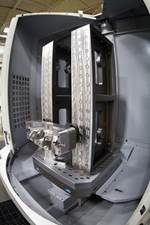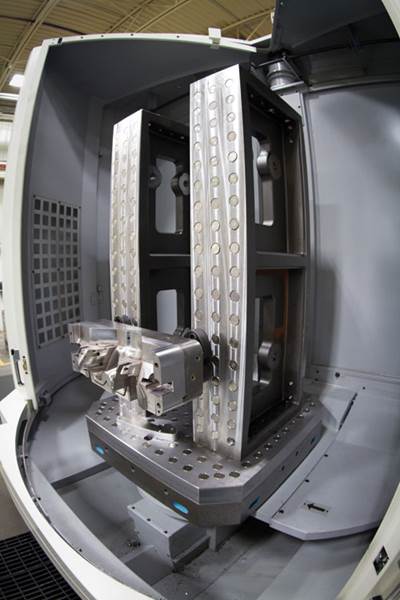How to Produce Consistent, Repeatable Electrodes
When it comes to electrode production, workholding and automation technology must be accurate and consistent to ensure repeatability and reduce machining time.
EDM and workholding go hand in hand when it comes to producing electrodes efficiently and accurately that will yield repeatable results. The EDM department can be vital to a shop that wishes to stay competitive and jump on the reshoring trend. Using EDM alone—or in conjunction with other machining technologies—can improve surface finishes and accuracies while reducing machining times. Brushing up on workholding trends can ensure your shop works at maximum productivity.
According to John Roskos, Vice President Sales, System 3R, USA LLC. (Elk Grove Village, IL), electrode production is critical to all EDM operations. “Consistency is as important as accuracy, so you eliminate the potential of re-burning the same surfaces and wasting productive time or not providing the same finish on all surfaces,” he emphasizes. “An electrode that is .0005” off center can add hours to the finishing time of a large cavity in the EDM.
“Accuracy is important to the overall project and the electrode holding device must be able to provide three times the required accuracy of the finished project,” Roskos continues. “If the electrode holding system can maintain 2 microns repeatability the moldmaker has a better chance of maintaining a 6-micron accuracy in his mold.”
Repeatable workholding is key, adds Chris Norman, COO, EROWA Technology, Inc. (Arlington Heights, IL). “When an electrode is produced on a workholding system, it is machined to a qualifying location that then can be repeated,” Norman says. “By taking the pallet that the electrode is attached to and using a common interface or chuck on all of the process machines, you eliminate additional aligning in the quill of the EDM machine or the grinder, mill or lathe during electrode production.” If there is subsequent redressing of the electrode, it can easily be set up back on the mill, grinder or lathe and repeat the location previously established. Then, it can be returned to the EDM without any required alignment provided the electrode remains on the pallet, Norman adds.
Roskos expands on these sentiments. “The palletization of EDM electrodes allows the moldmaker to produce electrodes with an accurate reference in the X, Y and Z axes,” he explains. “This allows for quick and accurate transfer from the electrode milling machine to the CMM then ultimately to the EDM machine. If the EDM is equipped with an automatic electrode changer the palletized electrode is the basis for simple automation.” Roskos also notes that a large mold cavity or several small cavities can be placed on the EDM table and machined around the clock when palletized electrodes load automatically.
A reliable workholding system is a must for unattended operation of the EDM, Roskos states. “This not only applies to the electrode holding system, but also the workpieces on the table,” he comments. “Palletization allows for accurate part registration with each set-up and all machine tools. A reliable workholding system guarantees quick and accurate transfers from machine to machine, CMM or other measuring devices. It provides a rigid platform without clamp interference or collision potential.”
This ensures reliability, which is a must to improve throughput and allow one to automate the process as demand increases, Roskos continues. “When palletized workpieces and electrodes are easily and accurately transferred from machine tool to machine tool the addition of automation becomes a natural step.”
Time savings is the main benefit, EROWA Technology’s Norman adds. “With a reliable repeatable workholding system, set-up time is greatly reduced in any machining procedure,” he says. “Typically the machine is running while the next job is being set up outside the machine. Then, when the job is ready to be put in the machine it is as simple as making a pallet change and starting the machining cycle. As long as a workpiece is set up on a pallet and the datum reference point location is known to the workholding system zero, no additional pick up is required in the machine tool.”
This time savings allows for much more spindle time in a day, Norman continues. “Even if the part is set up outside the machine on a pallet and then probed for location once the pallet is placed in the machine, there is still a huge time savings in the part set-up over setting it up on the table while the machine is idle.”
For electrode manufacturing a repeatable workholding system is the most advantageous way to go, Norman adds. “The electrode material—copper or graphite—is attached to a pallet then machined on the system chuck(s) in the toolroom,” he elaborates. “Then it can be moved directly to the quill of an EDM without any pick-up necessary. As long as the zero point is known on the manufacturing chuck(s) and the EDM quill chuck, repeatability is certain.”
Properly using workholding in conjunction with EDM technologies on the shop floor will go a long way in achieving maximum productivity on the shop floor without sacrificing accuracy and consistency.
Related Content
Laser Welding Versus Micro Welding
The latest battle in finely detailed restoration/repair of mold materials.
Read MoreMoldmakers Deserve a Total Production Solution
Stability, spindle speed and software are essential consideration for your moldmaking machine tool.
Read MoreMachining Center Spindles: What You Need to Know
Why and how to research spindle technology before purchasing a machining center.
Read MoreRead Next
Workholding System Reduces Set-up Times, Yields Flexibility
With the FCS system, mold shop is saving time in areas of workpiece preparation and locational pickup in the machining centers.
Read MoreHow to Use Strategic Planning Tools, Data to Manage the Human Side of Business
Q&A with Marion Wells, MMT EAB member and founder of Human Asset Management.
Read MoreReasons to Use Fiber Lasers for Mold Cleaning
Fiber lasers offer a simplicity, speed, control and portability, minimizing mold cleaning risks.
Read More


















